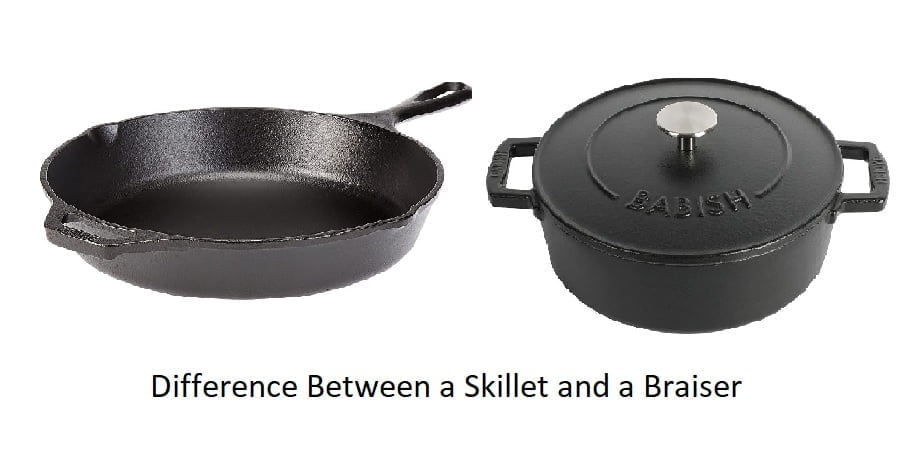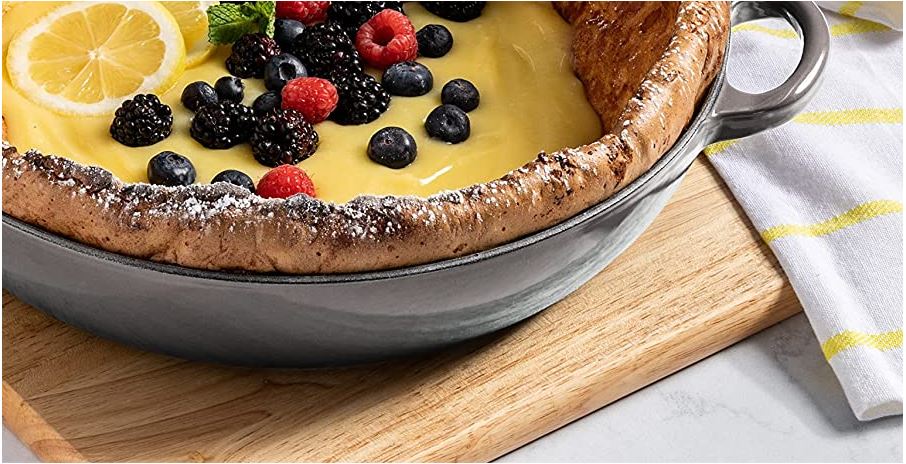Can You Use A Braiser As A Skillet? How?
Note: This article may contain affiliate links, which means if you make a purchase following our links won’t cost you extra, but we may earn a commission. Learn more
If you’re a home cook, you may have heard of the terms “braiser” and “skillet” in the kitchen. Although they have some similarities, there are differences between the two cookware that you should be aware of. One question that arises is, “Can you use a braiser as a skillet?”
A braiser and skillet are both versatile cookware that can be used for a wide range of recipes. They have different designs and functions. A braiser or a cast iron braiser is deeper than a skillet and comes with a tight-fitting lid, making it perfect for slow-cooking recipes that require moist heat. On the other hand, a skillet is a shallow, flat-bottomed pan that is great for searing, sautéing, and frying.
Although a braiser can’t replace a skillet, it can be used as one in some situations. For instance, if you need to fry some chicken pieces or cook a large steak, you can use a braiser as long as it has a flat bottom. Since a braiser has higher sides, it may take longer to heat up, and it may not be ideal for dishes that require high heat.
If you’re looking to invest in high-quality cookware, you might be wondering whether to buy a braiser or a skillet. A cast iron skillet is a classic option for searing and browning meats, while a braiser is perfect for slow-cooking stews, roasts, and braises. Le Creuset is a popular brand that offers both a skillet and a braiser.
Cooking with a braiser can be a delightful experience, and there are many recipes that you can make with it. Some popular dishes include Coq au Vin, Beef Bourguignon, and Pot Roast.
To use a braiser, you need to preheat it on low to medium heat, add some oil, and then add the ingredients. You can then cover the pan with a lid and let it simmer until the food is cooked.
Related: 6 Best Cast Iron Braiser Pans
difference between a skillet and a braiser
1. Depth
Skillets are shallow and wide, whereas braisers are deeper and narrower. This feature affects the cooking process, as a skillet is perfect for cooking recipes that require high heat, such as searing and sautéing. In contrast, a braiser is ideal for slow-cooking recipes that need to be simmered in a moist environment.
2. Lid
A skillet doesn’t come with a lid, while a braiser does. The lid helps to create a steamy environment, which is necessary for slow-cooking dishes like stews and casseroles. On the other hand, skillets are perfect for quick-cooking recipes that don’t require a lid.
3. Design
The design of the skillet and the braiser is another significant difference. A skillet has a flat bottom and sloping sides that make it perfect for stirring, tossing, and flipping ingredients. In contrast, a braiser has a flat bottom and higher sides, which helps to retain moisture and flavors, making it perfect for slow-cooking dishes that need to simmer for an extended period.
4. Versatility
Skillets and braisers are versatile cookware that can be used for a wide range of recipes. However, a skillet is more versatile than a braiser as it can be used for both high-heat and low-heat cooking methods. A braiser, on the other hand, is more suited to low-heat cooking methods and is ideal for making soups, stews, and braises.

how to use a braiser as a skillet?
A braiser is a versatile piece of cookware that can be used for different cooking techniques, including sautéing, braising, and frying. It’s possible to use a braiser as a skillet, especially if you don’t have a skillet or prefer using a braiser. Here’s how to use a braiser/cast iron braiser as a skillet.
1. Preheat: Start by preheating your braiser over medium heat for a few minutes. This will help to distribute the heat evenly and prevent your food from sticking to the bottom.
2. Add oil: Once the braiser is hot, add a small amount of oil to the bottom of the pan. You can use any oil of your choice, but make sure it has a high smoke point to prevent it from burning.
3. Add ingredients: Add your ingredients to the pan, making sure not to overcrowd it. Overcrowding the pan can cause your food to steam instead of sear. You can use a spatula to move the ingredients around the pan and prevent them from sticking.
4. Cook: Cook your food over medium to high heat, depending on the recipe you’re making. You can use a lid to cover the pan if necessary to create a steamy environment.
5. Serve: Once your food is cooked, serve it directly from the braiser or transfer it to a serving dish.
FAQs
What is a braiser, and how is it different from a skillet?
A braiser is a cooking vessel that is wider and shallower than a pot, with straight sides and a tight-fitting lid. It is designed for slow-cooking meats and vegetables in liquid. A skillet, on the other hand, is a flat-bottomed frying pan with sloping sides that are suitable for sautéing and searing.
Can I use a braiser as a skillet?
Yes, a braiser can be used as a skillet for cooking a variety of dishes, including seared meats and vegetables.
What are the benefits of using a braiser?
A braiser has several benefits, including even heat distribution, versatile cooking capabilities, and the ability to slow-cook meats and vegetables in liquid to create tender, flavorful dishes.

What types of recipes can I make in a skillet?
Skillets are ideal for cooking a range of recipes, including sautéed vegetables, seared meats, omelets, and frittatas.
What is the difference between a cast-iron skillet and a braiser?
A cast-iron skillet is a type of skillet made of cast iron that is known for its even heat distribution and non-stick properties. A braiser is wider and shallower than a pot and is designed for slow-cooking meats and vegetables in liquid.
Can I use a skillet in the oven?
Yes, most skillets are oven-safe and can be used for cooking dishes that require both stovetop and oven cooking.
What is the difference between a Le Creuset skillet and a braiser?
A Le Creuset skillet is a flat-bottomed frying pan with sloping sides that is suitable for sautéing and searing. A Le Creuset braiser, on the other hand, is wider and shallower than a pot and is designed for slow-cooking meats and vegetables in liquid. Both are made by the same brand and are known for their high-quality construction and durability.
To see our latest posts Click Here
